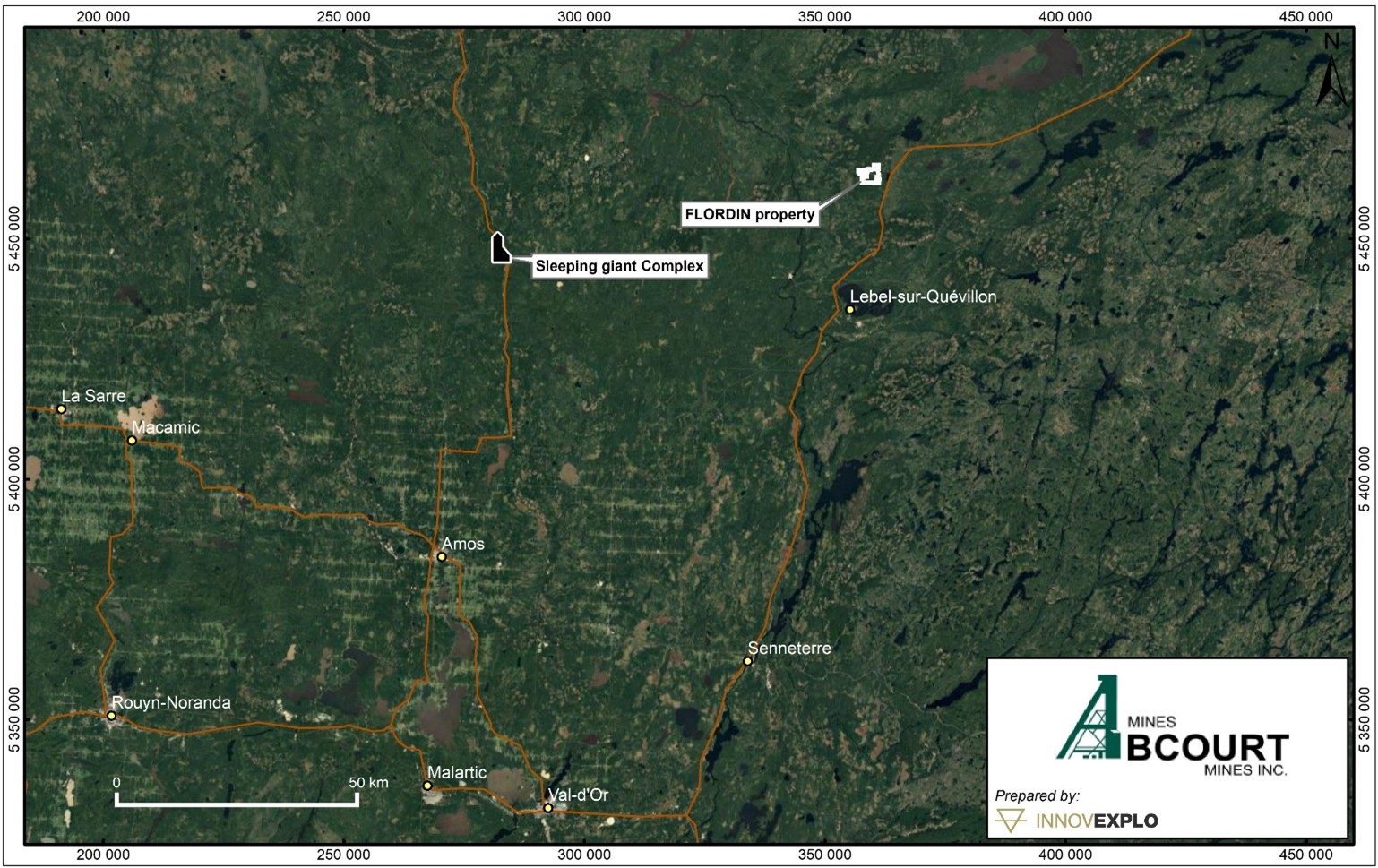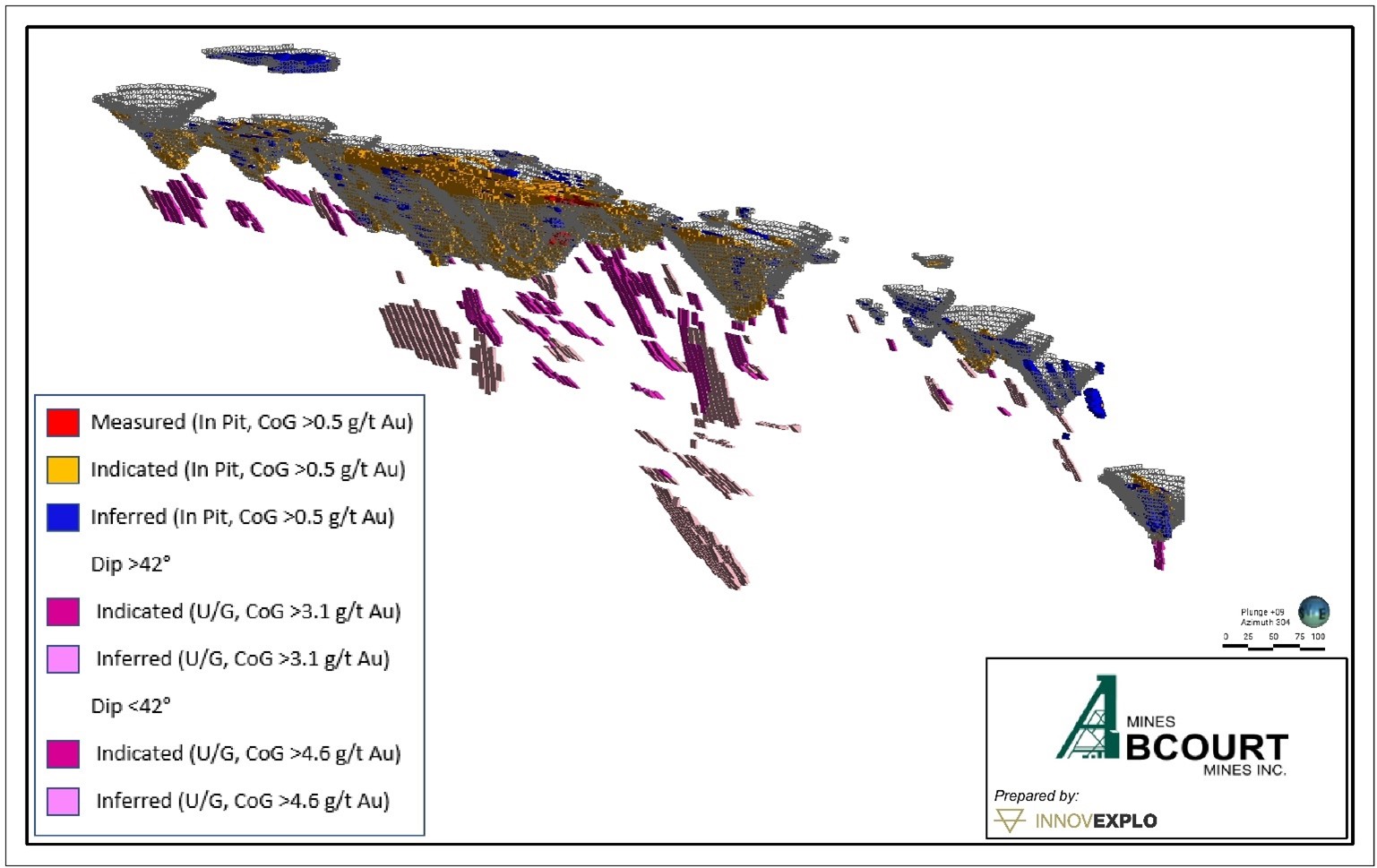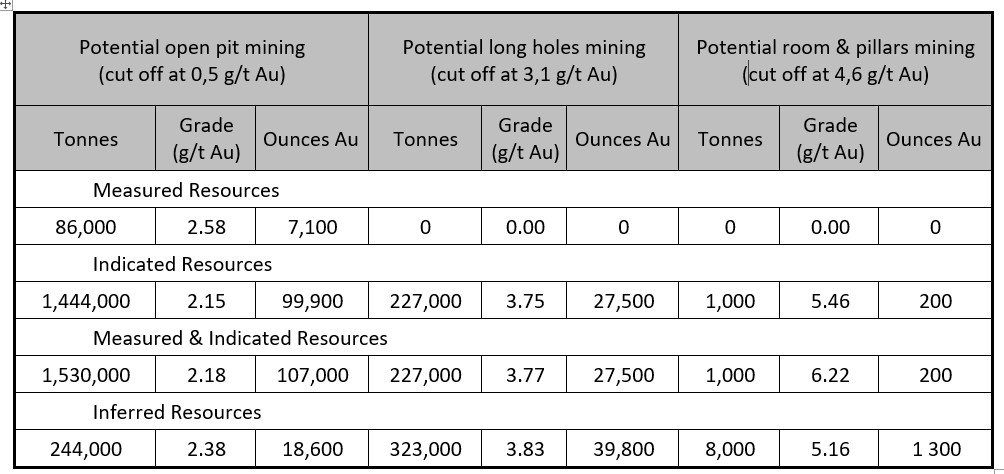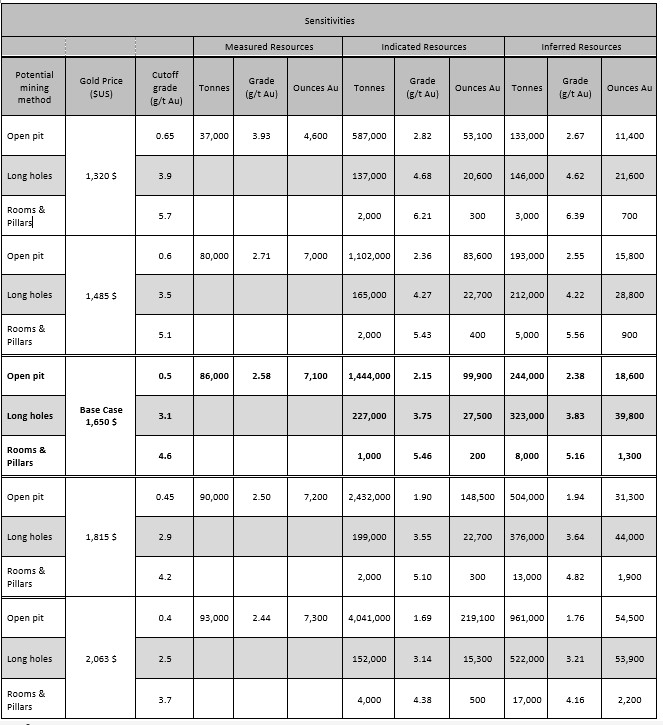Flordin property
The Flordin property is located approximately 25 km to the north of Lebel-sur-Quévillon, Quebec. It consists of 25 cells covering 976 hectares, 100% owned by Abcourt. In 2011, the project was re-assessed by Cadiscor Resources Inc. with an open pit plan. Again, the Company is prohibited to publish these results.
Here is a document (French only) about the FLORIN PROJECT on August 2024
Figure 1: Regional Map

This MRE reflects the results of approximately 73.4 thousand metres of drilling, of which 34.9 thousand metres were carried out from 2010 to 2020. The MRE was carried out by the firm InnovExplo of Val d’Or. The MRE uses a base case valued at a gold price of $1,650/oz. Please read the notes below Table 1 for the full list of the MRE evaluation criteria.
Highlights
- 134,700 ounces of Measured and Indicated Resources in 1,758,000 tonnes at an average grade of 2.38 g/t Au;
- 59,700 ounces of Inferred Resources in 575,000 tonnes at an average grade of 3.23 g/t Au;
- This MRE as well as the 3D model of the veins and the mineral structures will serve as a basis for carrying out an exploration campaign in the summer of 2023 with the aim of exploring the extensions of the deposit and potentially increasing the mineral resources.
Pascal Hamelin, President and CEO of Abcourt, said: “We are pleased to now own a third deposit with a mineral resource estimate near our Sleeping Giant mill. With our ore processing plant having all its permits, having processing and storage capacity, Abcourt has the potential to become a significant producer in a mining camp without any mill and several orphan deposits belonging to several companies.
Figure 2: Longitudinal View of the Flordin deposit

Table 1: Mineral Resources Estimate of the Flordin Gold Project

Notes to the 2023 MRE
- The effective date of the 2023 MRE is May 15, 2023.
- The independent and qualified persons (as defined by NI 43-101) for the 2023 MRE are Olivier Vadnais-Leblanc, P.Geo., Carl Pelletier, P.Geo., Eric Lecomte, P.Eng., and Simon Boudreau, P.Eng., from InnovExplo Inc,
- The mineral resource estimate follows the CIM Definition Standards (2014) and follows the CIM MRMR Best Practice Guidelines (2019).
- These mineral resources are not mineral reserves because they do not have demonstrated economic viability. The results are presented undiluted and are considered to have reasonable prospects for eventual economic extraction (RPEEE).
- The estimate encompasses 364 mineralized veins and structures developed using Genesis and interpolated using LeapFrog Edge.
- 1 m composites were calculated within the mineralized zones using the grade of the adjacent material when assayed or a value of zero when not assayed. High-grade capping supported by statistical analysis was done on composites and was set to 25 g/t Au.
- The estimate was completed using a sub-block model in Leapfrog Edge. A 10m x 2m x 2m (X,Y,Z) parent block size and a 1.25m x 0.25m x 0.25m (X,Y,Z) sub block size was used.
- Grade interpolation was obtained by Inverse Distance Squared (ID2) using hard boundaries.
- A density value of 2.8 g/cm3 was assigned to all mineralized zones.
- Mineral resources were classified into Measured, Indicated and Inferred. Measured resources are defined within a distance of 8m from underground or surface channel and from a minimum of three (3) drill holes in areas where the drill spacing is less than 50 m. Indicated resources are defined with a minimum of three (3) drill holes in areas where the drill spacing is less than 50 m. The Inferred category is defined with two (2) drill hole in areas where the drill spacing is less than 75 m where there is reasonable geological and grade continuity.
- The requirement of a reasonable prospect of eventual economic extraction is satisfied by having cut-off grades based on reasonable parameters for potential surface and underground extraction scenarios, minimum widths and constraining volumes. The estimate is presented for potential underground scenarios (realized in Deswik) over a width of 1.7m for blocks 16m high by 16m long at a cut-off grade of 3.10 g/t Au for the long-hole method (LT) and 4.60 g/t Au for the conventional room and pillar (CP) method. Cut-off grades reflect the actual geometry and dip of the mineralized envelopes. The pit of the 2023 mineral resource estimate is locally constrained by an optimized surface in Whittle using a rounded cut-off grade of 0.5 g/t Au. Cut-off grades reflect the actual geometry and dip of the mineralized envelopes. The cut-off grades were calculated using the following parameters: a slope of 50° in the rock and 30° in the overburden, a pit mining cost = C$4.65/t, an underground mining cost of C $169.50/t for LT and C$262.00/t for CP, a processing cost of C$21.50/t, general and administrative costs of C$12.00/t, selling costs of C$5.00/oz, a price of gold of US$1,650 per ounce, a USD/CAD exchange rate of 1.33 and a mill recovery rate of 91.7%. Cut-off grades should be re-evaluated in light of future market conditions (metal prices, exchange rates, mining cost, etc.).
- The number of metric tonnes was rounded to the nearest thousand, following the recommendations in NI 43-101 and any discrepancies in the totals are due to rounding effects. The metal contents are presented in troy ounces (tonnes x grade / 31.10348) rounded to the nearest hundred. Numbers may not add up due to rounding.
- The independent and qualified persons for the 2023 MRE are not aware of any known environmental, permitting, legal, political, title-related, taxation, socio-political, or marketing issues that could materially affect the Mineral Resource Estimate.
Table 2: MRE sensitivities according to the price of gold

This MRE adheres to current Canadian standards for the disclosure of mineral resources and reserves as created by the Canadian Institute of Mining (“CIM”) and defined in the CIM Definition Standards for Mineral Resources and Mineral Reserves dated May 2014 (“ICM Definition Standards”). The MRE also complies with the CIM Best Practice Guidance on Estimating Mineral Resources and Mineral Reserves dated November 2019 (“CIM MRMR Best Practice Guidance”).
This MRE includes the amalgamation of blocks of various grades (“mandatory blocks”) included within potential mining forms respecting the reasonable prospect of eventual economic extraction, as specified by the CIM in 2019.



